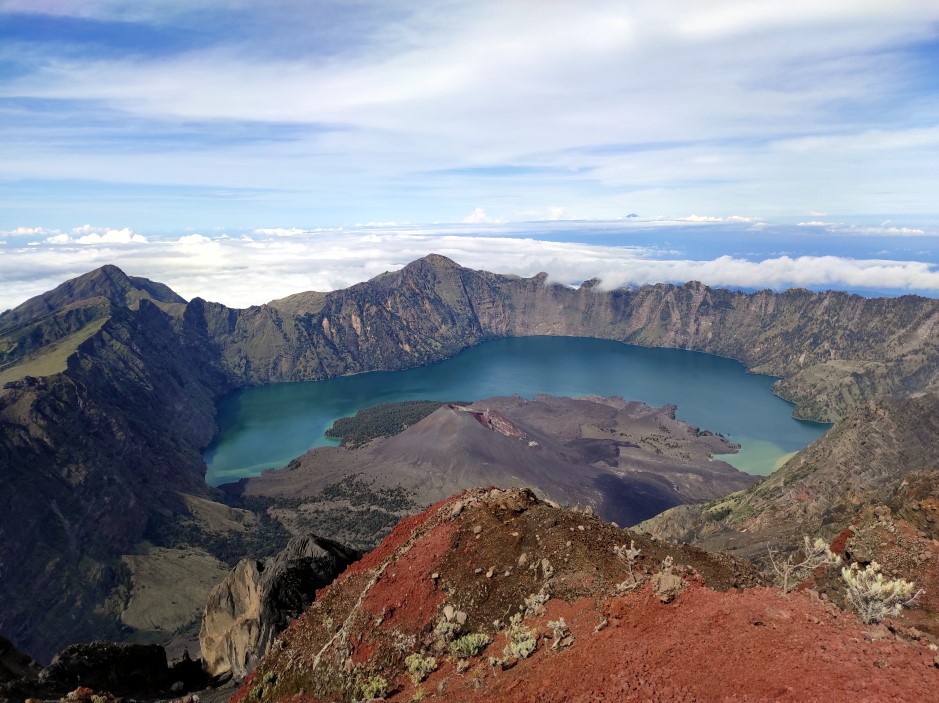
Mount Tambora
Mount Tambora, also known as Gunung Tambora, is an active stratovolcano located on the island of Sumbawa in Indonesia. It is part of the Sunda Arc, a chain of volcanic islands formed by the subduction of the Indo-Australian Plate beneath the Eurasian Plate. The volcano is most famous for its massive eruption in 1815, which is considered one of the most powerful volcanic eruptions in recorded history.
The 1815 eruption of Mount Tambora had a Volcanic Explosivity Index (VEI) of 7, making it a super-colossal eruption. The event released an estimated 160 cubic kilometers (38 cubic miles) of volcanic material into the atmosphere, causing global climatic effects. The following year, 1816, was referred to as the “Year Without a Summer” due to the significant drop in temperatures worldwide. This led to widespread crop failures, food shortages, and famines in many parts of the world.
The eruption also produced tsunamis and pyroclastic flows that devastated nearby regions. It is estimated that around 71,000 people were killed as a direct result of the eruption, with many more affected by the subsequent climate change and crop failures.
Since the 1815 eruption, Mount Tambora has been relatively quiet, with minor eruptions and seismic activity occurring periodically. However, due to its history and location in a seismically active region, scientists continue to monitor the volcano for signs of potential future eruptions.
One of the largest volcanic eruptions in history
The 1815 eruption of Mount Tambora was one of the largest eruptions in recorded history, but not the absolute largest. The Tambora eruption had a Volcanic Explosivity Index (VEI) of 7, which classifies it as a super-colossal eruption. However, there have been a few eruptions in Earth’s history that were even larger.
One such eruption was the Toba supereruption that occurred around 74,000 years ago on the island of Sumatra, Indonesia. The Toba eruption had an estimated VEI of 8, making it a mega-colossal eruption and one of the most powerful volcanic events known. The Toba eruption released an estimated 2,800 cubic kilometers (670 cubic miles) of volcanic material, far exceeding the amount released by Tambora.
Another notable eruption was the eruption of the La Garita Caldera in present-day Colorado, United States, which occurred around 28 million years ago. This eruption is also thought to have had a VEI of 8, releasing over 5,000 cubic kilometers (1,200 cubic miles) of volcanic material.
While the Tambora eruption was not the largest in history, it remains one of the most significant due to its dramatic impact on global climate and human societies in the early 19th century.
Krakatoa was only the second biggest eruption in the 1800s in Indonesia. The 1816 eruption of Mount Tambora was so ferocious that it almost instantly killed 10,000 people on the island of Sumbawa and ultimately took about 90,000 lives.
Getting There
To visit Mount Tambora, you’ll need to travel to the island of Sumbawa in Indonesia. Here’s a general outline of the steps you can follow:
- International flight to Indonesia: Book a flight to Indonesia, typically landing at Soekarno-Hatta International Airport (CGK) in Jakarta, the capital city, or Ngurah Rai International Airport (DPS) in Denpasar, Bali.
- Domestic flight to Lombok or Sumbawa Besar: From either Jakarta or Denpasar, take a domestic flight to Lombok International Airport (LOP) in Lombok or Sultan Muhammad Kaharuddin III Airport (SWQ) in Sumbawa Besar, Sumbawa.
- Ground transportation to the village of Pancasila or Doro Ncanga: From Lombok, you can take a ferry to Sumbawa and then hire a car or take a bus to Pancasila or Doro Ncanga. If you’ve landed in Sumbawa Besar, you can also hire a car or take a bus to reach one of these villages.
- Local guide and trekking tour: It is recommended to arrange for a local guide and join a trekking tour for the best experience and safety. You can usually find tour operators in Pancasila or Doro Ncanga who can help you with permits, guides, and porters if needed.
- Trek to Mount Tambora: The trek to Mount Tambora typically takes 2-4 days round-trip, depending on your starting point, pace, and preferred route. It’s essential to be well-prepared with proper clothing, footwear, and supplies, as the trek can be challenging.
Keep in mind that the situation regarding travel and trekking might change due to various factors, such as local regulations or the current state of the volcano. Be sure to check for updated information and advice before planning your trip.
